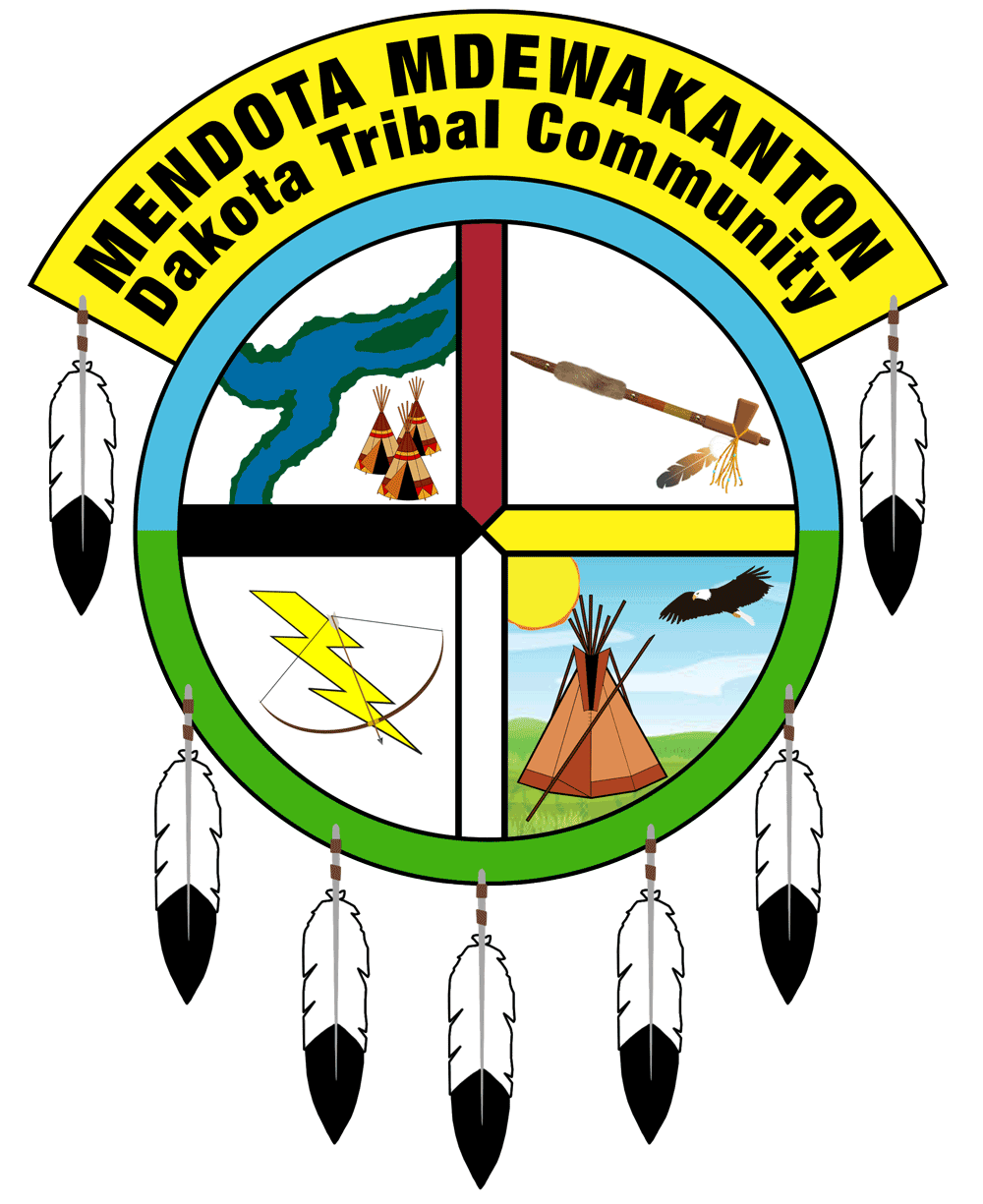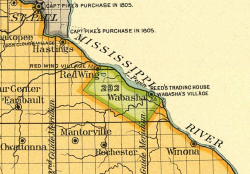“Half-Breed” Tract
- Cite
- Johnson, Frederick. “”Half-Breed” Tract.” MNopedia, Minnesota Historical Society. http://www.mnopedia.org/place/half-breed-tract (accessed May 6, 2021).
The 1830 Treaty of Prairie du Chien set aside 320,000 acres of potentially valuable land west of Lake Pepin for so-called “half-breed” members of the Dakota nation. The move set off a series of events that would enrich a number of early Minnesotans—none of them of Native American heritage.
In 1830, United States government officials traveled to Prairie du Chien, in what later became Wisconsin, a former French Canadian fur post on the Mississippi River. They hoped to negotiate peace among the Dakota, Sac, and Ho-Chunk people in the region. The resulting treaty would also extend the government’s influence into the vast northwestern frontier then controlled by Native Americans.
Part of the treaty allowed the Dakota to set aside a parcel of land for mixed-race relatives, known in the vernacular of the day as “half breeds.” White traders, trappers and other Caucasians in the region often had Dakota or mixed-race wives. Children from these unions would be among those benefiting from this land reserve, which became known as the “Half-Breed Tract.”
Article 9 of the treaty described it as a parcel of land west of Lake Pepin. The land remained largely unoccupied for two decades. However, the signing of US–Dakota land treaties in 1851 brought eager settler-colonists rushing into Minnesota Territory to claim Indigenous lands, even before the agreement had been ratified. The new arrivals staked out land, including some in the tract, and began improving their holdings. Then, they waited for the official government survey and land sale. Their actions placed the Half-Breed Tract in limbo. Traders worked to get their mixed race relatives a $150,000 cash settlement in exchange for their tract rights, but failed.
Henry Rice, a Minnesota territorial delegate to the US Senate, hadn’t forgotten the Half-Breed Tract. In July 1854, he convinced the Senate to offer the mixed-race claimants a deal. Each could get up to 640 acres of unsurveyed federal lands by giving up their claim to the Half-Breed Tract. Those eligible would receive “exchanging scrip,” certificates that could be used to buy land.
In the spring of 1857, scrip finally arrived in Minnesota and was distributed at Wabasha, Red Wing, and other places near the tract. Eligible adults and legal guardians of the qualified received government paper in varying amounts. Although the sale of scrip was supposedly prohibited, land speculators bought as much of it as they could. Typically, it was cheap.
In the Red Wing area, some scrip holders went to the US Land Office and presented paper for tract land already occupied by settlers. These buyers asserted that the claims of the two hundred occupiers who had moved in to the Half-Breed Tract before the treaty was ratified were not valid. With law enforcement weak in Minnesota Territory, however, angry settlers took control of the situation. They set up a committee of vigilance to protect themselves and the land they claimed. Two armed guards stood watch at the land office to keep scrip holders away.
The vigilantes’ intimidation worked. They forced rival claimants to return to the land office and take back their scrip. The federal government resolved the dangerous situation in May 1858. As part of the deal, the settlers who illegally occupied acreage in the tract in 1851 and 1852 received the rights to the land they had been living on.
The story of the Half-Breed Tract scrip was not over. Following the US-Dakota War of 1862, speculators worked to get the scrip from mixed bloods still holding it. These valuable papers could be exchanged for lands anywhere in the public domain. That included most of the US-controlled lands west of the Mississippi River.
Minnesota “half-breed” scrip bought valuable land around Carson City, Nevada, during the 1860s Comstock silver rush. It was used to acquire stands of timber near Lake Tahoe. In 1865, a Minnesota speculator working with California colleagues used scrip to purchase nine thousand acres of California redwood trees at $5 per acre, plus half the profits after sale. In the 1880s, scrip was used to claim unsurveyed federal land in Minnesota’s northern iron ore district. Mining had begun there in 1884.
For those savvy enough to buy it—unscrupulously, in most cases—Minnesota’s “half-breed” scrip produced breathtaking profits.

First published: July 24, 2013
Last modified: May 28, 2019
- BIBLIOGRAPHY
- RELATED RESOURCES
A/m.B158
Alexis Bailly Papers, 1821–1868
Account Books
Manuscript Collection, Minnesota Historical Society, St. Paul
Description: Microfilm correspondence and financial records of Bailly, an American Fur Company agent at Mendota, 1820–1835, and later at Wabasha, giving details of trade with the Dakota.
Curtiss-Wedge, Franklyn. History of Goodhue County, Minnesota. Chicago: H.C. Cooper, Jr., 1909.
Folwell, William Watts, “Sioux Half-Breed Scrip, appendix 11.” In A History of Minnesota, vol. 1. St. Paul: Minnesota Historical Society, 1956 edition.
Gates, Paul W. A History of Public Land Law Development. New York: Arno Press, 1979.
Hancock, Joseph Wood. Goodhue County, Minnesota Past and Present. Red Wing, MN: Red Wing Printing Co., 1893.
History of Goodhue County. Red Wing, MN: Wood, Alley & Co., 1878.
Johnson, Frederick L. Goodhue County, Minnesota: A Narrative History. Red Wing, MN: Goodhue County Historical Society, 2000.
Meyer, Roy W. History of the Santee Sioux. Lincoln: University of Nebraska Press, 1967.
———. “The Red Wing Indian Village.” Unpublished manuscript. Red Wing, MN: Goodhue County Historical Society Collections, 1963.
Millikan, William. “The Great Treasure of the Fort Snelling Prison Camp.” Minnesota History 62, no. 1 (Spring 2010): 4–15. http://collections.mnhs.org/MNHistoryMagazine/articles/62/v62i01p004-017.pdf
M587
Northwest Missions Manuscripts and Index, 1766–1926.
Manuscript Collection, Minnesota Historical Society, St. Paul.
http://www.mnhs.org/library/findaids/00784.xml
Description: Typed transcripts and negative photocopies of letters, diaries, church records, and articles pertaining to Protestant and Catholic missions to the Ojibwe and Dakota in Michigan, Wisconsin, Minnesota, Dakota Territory, and neighboring areas in Canada (1810-1896); and a card index to these and other items relating to northwest missions (1766-1926). Compiled by Grace Lee Nute.
Pond, Samuel W. The Dakotas or Sioux in Minnesota as they were in 1834. St. Paul: Minnesota Historical Society, reprint, 1986.
Riggs, Stephen R. “Dakota Portraits.” Minnesota History Bulletin 2 (November 1918): 481–568.
Register of Sioux Half-Breed Scrip, 1857–1861
United States, Red Wing Land District
State Archives Collection, Minnesota Historical Society, St. Paul
Description: An abstract of land entries made in the Red Wing district with Sioux half-breed scrip, issued to mixed-race Dakota to extinguish their title to land originally reserved to them by the Treaty of Prairie du Chien.
M550
Office of Indian Affairs: Records Related to Mixed Blood Claimants under the Treaty of Prairie du Chien, 1855–1856
Manuscript Collection, Minnesota Historical Society, St. Paul
Description: Records related to claims made by mixed blood Dakota under the Treaty of Prairie du Chien, 1830. See “Roll of Mixed Blood Claimants, 1856.”
Sioux Lands or Reservation in Minnesota Territory. House Report Doc. No. 138, 33rd Cong., 1st Sess. (1854).
Oklahoma State University Library Electronic Publishing Center. Treaty of Prairie du Chien, 1830.
http://digital.library.okstate.edu/kappler/VOL2/treaties/sau0305.htm#mn12
Walker Thomas, “Memories of Early Life and Development of Minnesota.” Minnesota Historical Society Collections 15 (1915): 463.

